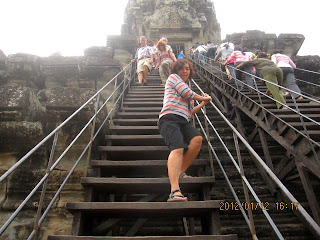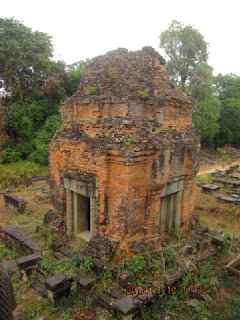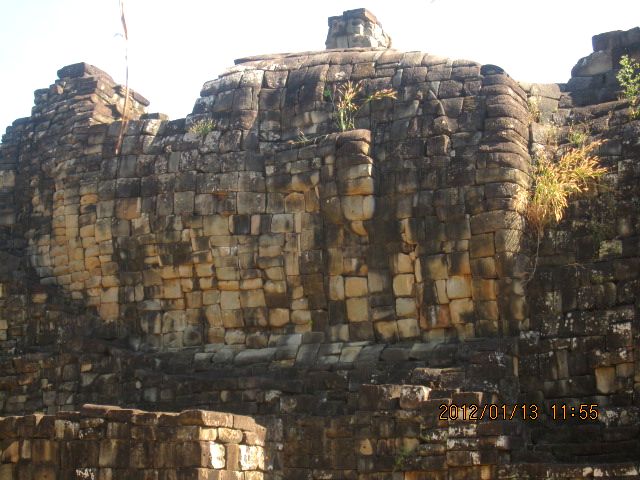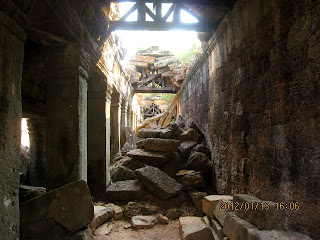TOUR - operated by the Irrawady Floatilla Company.
RV Mekong Pandaw
Siem Reap to Ho Chi Mhin City
Pre & Post cruise tours
20% Discount (River Cruise)
Friends in Songkhla have previously toured with this company, and we in fact on a 14 day cruise in Burma, when we decided to take a LUXURY CRUISE!!
Owen & Kag, our long term friends and residents of Songkhla were keen. Booking's made, and visa's arrived the evening before we departed from Bangkok to Cambodia - cutting it fine!
With a population of over 14.8 million, Cambodia is the 69th most populous country in the world. The official religion is Theravada Buddhism which is practiced by around 95% of the Cambodian population. The country minority groups include Vietnamese, Chinese, Chams and 30 various hill tribes.[6] The capital and largest city is Phnom Penh; the political, economical, and cultural center of Cambodia.
The kingdom is a constitutional monarchy with Norodom Sihamoni, an elected monarch chosen by the Royal Throne Council, as head of state. The head of government is Hun Sen, who is currently the longest serving leader in South East Asia and has ruled Cambodia for over 25 years.
In 802 AD Jayavarman II declared himself king which marked the beginning of the Khmer Empire. Successive kings flourished which marked the Khmer empire's immense power and wealth who dominate much of South East Asia for over 600 years. Cambodia was ruled as a vassal between its neighbors, until it was colonized by the French in mid-19th century. Cambodia gained independence in 1953. The Vietnam War extended into Cambodia, giving rise to the Khmer Rouge, which took Phnom Penh in 1975. Cambodia reemerged several years later within a socialistic sphere of influence as the People's Republic of Kampuchea until 1993. After years of isolation, the war-ravaged nation was reunited under the monarchy in 1993.
Rebuilding from decades of civil war, Cambodia has seen rapid progress in the economic and human resource areas. The country has had one of the best economic records in Asia, with economic growth growing an average 6.0% for the last 10 years. Strong textiles, agriculture, construction, garments, and tourism sectors led to foreign investments and international trade.[7] In 2005, oil and natural gas deposits were found beneath Cambodia's territorial waters, and once commercial extraction begins in 2013, the oil revenues could profoundly affect Cambodia's economy.[8]
Pre-cruise tour - Angkor Wat with numerous others included in our two days
Owen and Kag enjoying the joy's of air travel - airports!!
Bangkok Airway's the only airline servicing Siem Reap direct from Bangkok. Sue's happy to be on the GROUND!
No drama with visa on arrival - US$20 (cash), just watch your passport pass down the line of officials.
They will call your name to collect!
Our Tour guide and driver were eagerly awaiting our arrival, and we were soon slumming it at the Vistoria Resort & Spa.
A quick walk around the Royal Independance Gardens found a craft fair in full swing, of interest was the silk weaving and spinning. Otherwise it was local and regional products for sale!
Hot water to pickup the silk thread and spin onto the wheel,
very simple.
Lunch included - Day 1, Buffet breakfast for days 2 & 3.
Just watch for the extra's not included - Water US$7 ++
Fancy food and very tasty!
Hotel atrium complete with wild life____
See what I mean! Don't fall in the pond.
Our 1st Temple - ANGKOR WAT
Angkor Wat is a temple complex at Angkor, Cambodia, built for the king Suryavarman II in the early 12th century as his state temple and capital city. As the best-preserved temple at the site, it is the only one to have remained a significant religious centre since its foundation — first Hindu, dedicated to the god Vishnu, then Buddhist. It is the world's largest religious building. The temple is at the top of the high classical style of Khmer architecture. It has become a symbol of Cambodia, appearing on its national flag, and it is the country's prime attraction for visitors.
Hindu mythology: within a moat and an outer wall 3.6 km long are three rectangular galleries, each raised above the next. At the centre of the temple stands a quincunx of towers. Unlike most Angkorian temples, Angkor Wat is oriented to the west; scholars are divided as to the significance of this. The temple is admired for the grandeur and harmony of the architecture, its extensive bas-reliefs and for the numerous devatas (guardian spirits) adorning its walls.
The modern name, Angkor Wat, means "City Temple"; Angkor is a vernacular form of the word nokor which comes from the Sanskrit word nagara meaning capital or city. Wat is the Khmer word for temple. Prior to this time the temple was known as Preah Pisnulok, after the posthumous title of its founder, Suryavarman II.
The modern name, Angkor Wat, means "City Temple"; Angkor is a vernacular form of the word nokor which comes from the Sanskrit word nagara meaning capital or city. Wat is the Khmer word for temple. Prior to this time the temple was known as Preah Pisnulok, after the posthumous title of its founder, Suryavarman II.
A collection of photo's follow - they do not do it justice, so you will just have to make the trip one day!!
Pre- Tour recommendations - Hint lot's of STAIRS!
1. Cardiac fitness evaluation
2. Knee reconstructions if you have wobbly knees!
Great views - but what goes up, comes down!
Yep! those stairs are steep & plenty of them!
Constructed more than two centuries before Angkor Wat, Phnom Bakheng was in its day the principal temple of the Angkor region, historians believe. It was the architectural centerpiece of a new capital, Yasodharapura, that Yasovarman built when he moved the court from the capital Hariharalaya in the Roluos area located to the southeast.
An inscription dated 1052 AD. and found at the Sdok Kak Thom temple in present-day Thailand states in Sanskrit: "When Sri Yasovardhana became king under the name of Yasovarman, the able Vamasiva continued as his guru. By the king's order, he set up a linga on Sri Yasodharagiri, a mountain equal in beauty to the king of mountains."[1] Scholars believe that this passage refers to the consecration of the Phnom Bakheng temple approximately a century and a half earlier.
Phnom Bakheng is a symbolic representation of Mount Meru, home of the Hindu gods, a status emphasized by the temple’s location atop a steep hill. The temple faces east, measures 76 meters square at its base and is built in a pyramid form of six tiers. At the top level, five sandstone sanctuaries, in various states of repair, stand in a quincunx pattern—one in the center and one at each corner of the level’s square. Originally, 108 small towers were arrayed around the temple at ground level and on various of its tiers; most of them have collapsed.[3]
Crowds of tourist arriving at South Gate of Angkor Thom
The South Gate Of Angkor Thom, Angkor
The five gates to Angkor Thom are all similar. The openings are 3.5 meters wide and 7 meters high. Originally they would also have been furnished with double wooden doors, mounted on pivots, which were apparently fitted with a horizontal closing bar, the holes for which still remain visible in the walls.
Angkor Thom literally: "Great City"), located in present day Cambodia, was the last and most enduring capital city of the Khmer empire. It was established in the late twelfth century by king Jayavarman VII. It covers an area of 9 km², within which are located several monuments from earlier eras as well as those established by Jayavarman and his successors. At the centre of the city is Jayavarman's state temple, the Bayon, with the other major sites clustered around the Victory Square immediately to the north.
Angkor Thom was established as the capital of Jayavarman VII's empire, and was the centre of his massive building programme. One inscription found in the city refers to Jayavarman as the groom and the city as his bride.
Angkor Thom seems not to be the first Khmer capital on the site, however. Yasodharapura, dating from three centuries earlier, was centred slightly further northwest, and Angkor Thom overlapped parts of it. The most notable earlier temples within the city are the former state temple of Baphuon, and Phimeanakas, which was incorporated into the Royal Palace. The Khmers did not draw any clear distinctions between Angkor Thom and Yashodharapura: even in the fourteenth century an inscription used the earlier name. The name of Angkor Thom — great city — was in use from the 16th century.
The Baphuon is a temple at Angkor, Cambodia. It is located in Angkor Thom, northwest of the Bayon. Built in the mid-11th century, it is a three-tiered temple mountain built as the state temple of Udayadityavarman II dedicated to the Hindu God Shiva. It is the archetype of the Baphuon style. The temple adjoins the southern enclosure of the royal palace and measures 120 metres east-west by 100 metres north-south at its base and stands 34 meters tall without its tower, which would have made it roughly 50 meters tall. Its appearance apparently impressed Emperor Chengzong of Yuan China's late 13th century envoy Chou Ta-Kuan during his visit from 1296 to 1297, who said it was 'the Tower of Bronze...a truly astonishing spectacle, with more than ten chambers at its base.' In the late 15th century, the Baphuon was converted to a
Buddist Temple
A 9 meter tall by 70 meter long statue of a reclining Buddha was built on the west side's second level, which probably required the demolition of the 8 meter tower above, thus explaining its current absence. The temple was built on land filled with sand, and due to its immense size the site was unstable throughout its history. Large portions had probably already collapsed by the time the Buddha was added.
Massive tree roots engulfed the stone work
As seen here, with an Extreme Knitting advocate
The Terrace of the Elephants is part of the walled city of Angkor Thom, a ruined temple complex in Cambodia. The terrace was used by Angkor's king Jayavarman VII as a platform from which to view his victorious returning army. It was attached to the palace of Phimeanakas, of which only a few ruins remain. Most of the original structure was made of organic material and has long since disappeared. Most of what remains are the foundation platforms of the complex. The terrace is named for the carvings of elephants on its eastern face.
The 350m-long Terrace of Elephants was used as a giant reviewing stand for public ceremonies and served as a base for the king's grand audience hall. It has five outworks extending towards the Central Square-three in the centre and one at each end. The middle section of the retaining wall is decorated with life size garuda and lions; towards either end are the two parts of the famous parade of elephants complete with their Khmer mahouts.
Lunch - down town in the Old City - Market area.
Fried fruit stick - actually tasted good.
Over lunch the consensus was - we were TEMPLED OUT! Thus would visit the most important one's today and not visit any Saturday morning, before departing on our bus to the cruise ship RV Mekong Pandaw!
The most recognised besides Angkor Wat - you will see __!
Ta Prohm (is the modern name of a temple at Angkor, Siem Reap Province, Cambodia, built in the Bayon style largely in the late 12th and early 13th centuries and originally called Rajavihara Located approximately one kilometre east of Angkor Thom and on the southern edge of the East Baray, it was founded by the Khmer King Jayavarman VII as a Mahayana Buddhist monastery and university. Unlike most Angkorian temples, Ta Prohm has been left in much the same condition in which it was found: the photogenic and atmospheric combination of trees growing out of the ruins and the jungle surroundings have made it one of Angkor's most popular temples with visitors.
Slab by slab being repaired, these guy's have a job for LIFE!
After the fall of the Khmer empire in the 15th century, the temple of Ta Prohm was abandoned and neglected for centuries. When the effort to conserve and restore the temples of Angkor began in the early 20th century, the École française d'Extrême-Orient decided that Ta Prohm would be left largely as it had been found, as a "concession to the general taste for the picturesque." According to pioneering Angkor scholar Maurice Glaize, Ta Prohm was singled out because it was "one of the most imposing [temples] and the one which had best merged with the jungle, but not yet to the point of becoming a part of it".[5] Nevertheless, much work has been done to stabilize the ruins, to permit access, and to maintain "this condition of apparent neglect
No doubt you have seen the POST CARD! or TOMB RAIDERS!
As of 2010, however, it seems authorities have started to take a more aggressive approach to restoration. All the plants and shrubs have been cleared from the site and some of trees are also getting removed A crane has been erected and a large amount of building work is underway to restore the temple, with much of the work seemingly just rebuilding the temple from scratch as at other sites. Wooden walkways, platforms, and roped railings have been put in place around the site which now block some of the previously famous postcard photo opportunities.
Look closely and you will find an image smiling
at you amongst the roots!
The trees growing out of the ruins are perhaps the most distinctive feature of Ta Prohm, and "have prompted more writers to descriptive excess than any other feature of Angkor." Two species predominate, but sources disagree on their identification: the larger is either the silk-cotton tree (Ceiba pentandra) or thitpok Tetrameles nudiflora, and the smaller is either the strangler fig (Ficus gibbosa). or Gold Apple (Diospyros decandra).
Last Temple - promise!!
Preah Khan, sometimes transliterated as Prah Khan, is a temple at Angkor, Cambodia, built in the 12th century for King Jayavarman VII. It is located northeast of Angkor Thom and just west of the Jayatataka baray, with which it was associated. It was the centre of a substantial organisation, with almost 100,000 officials and servants. The temple is flat in design, with a basic plan of successive rectangular galleries around a Buddhist sanctuary complicated by Hindu satellite temples and numerous later additions. Like the nearby Ta Prohm, Preah Khan has been left largely unrestored, with numerous trees and other vegetation growing among the ruins.
Our tour guides - both very well informed,
to the point of information over load!
Okay just one last TEMPLE photo - cheers!
Off to the markets and food hawkers in the old city of Siem Reap - hanging on!
Noodles $1.5
By the way, US$ are the preferred currency.
Beer is .50c to .75c for draft - $1 for cans
The fish were very happy chewing on dead skin!
Too 'WEARY' to climb more STAIRS!
Champagne breakfast - why not!
CHEER'S from Graham, Sue, Owen & Kag

































































































































